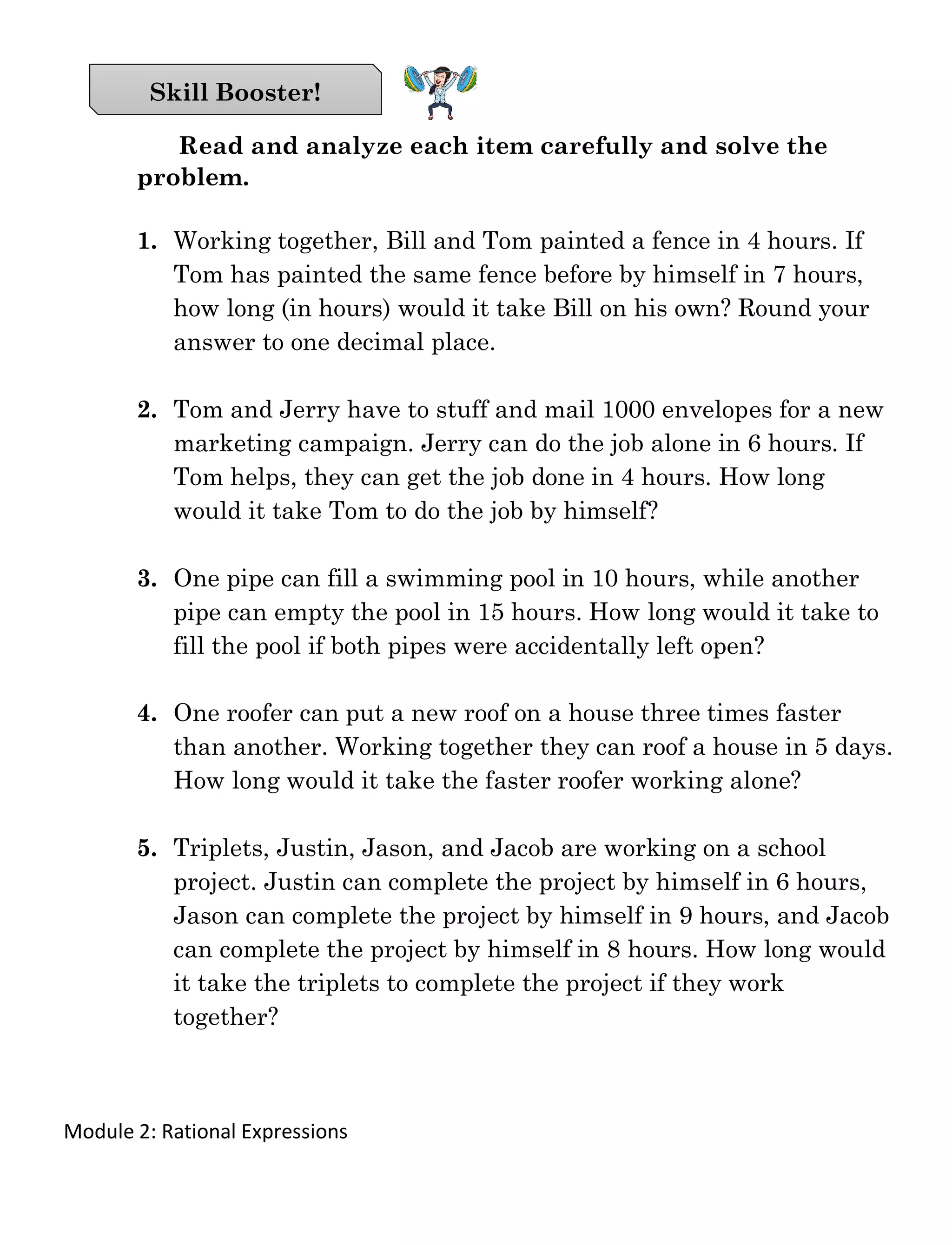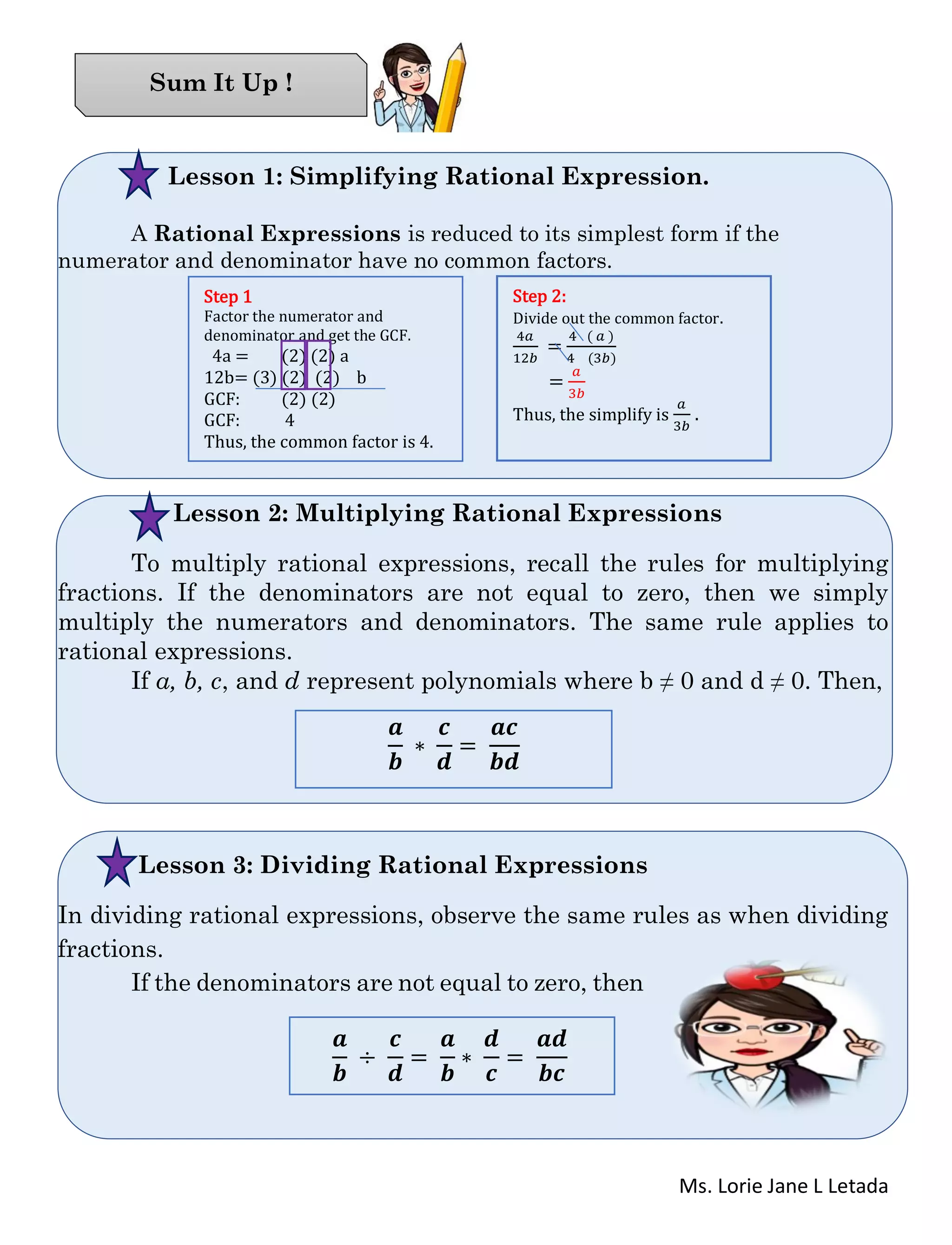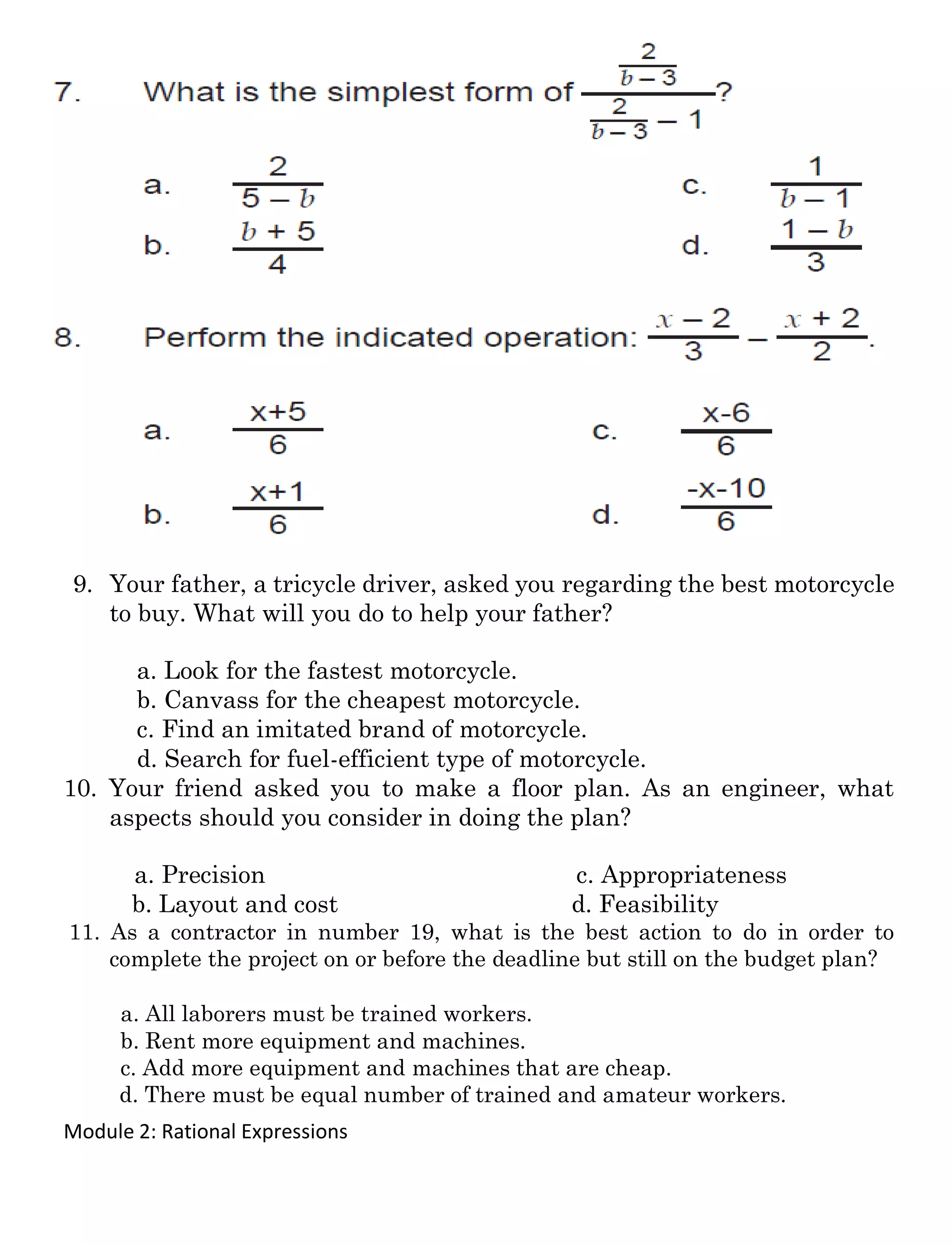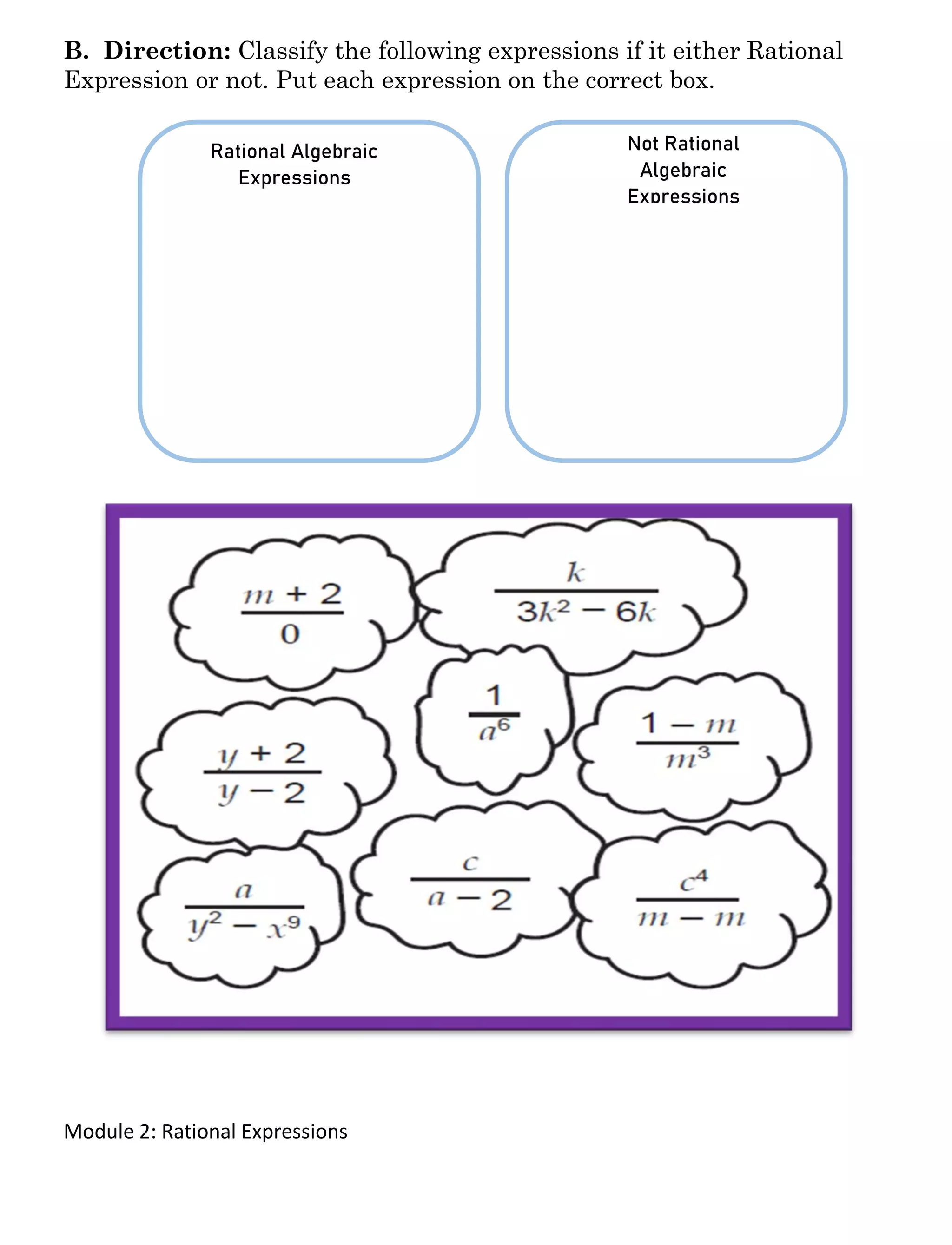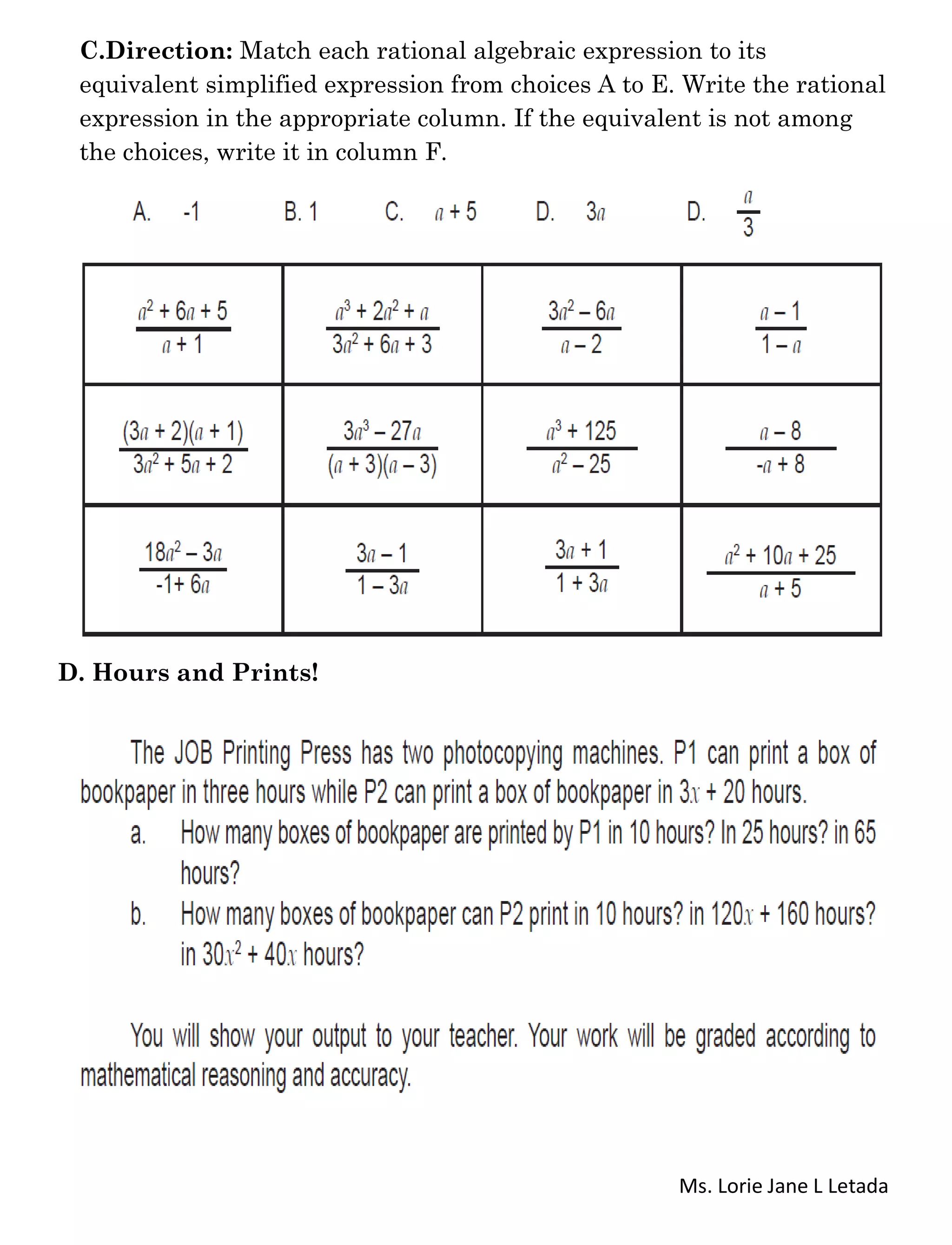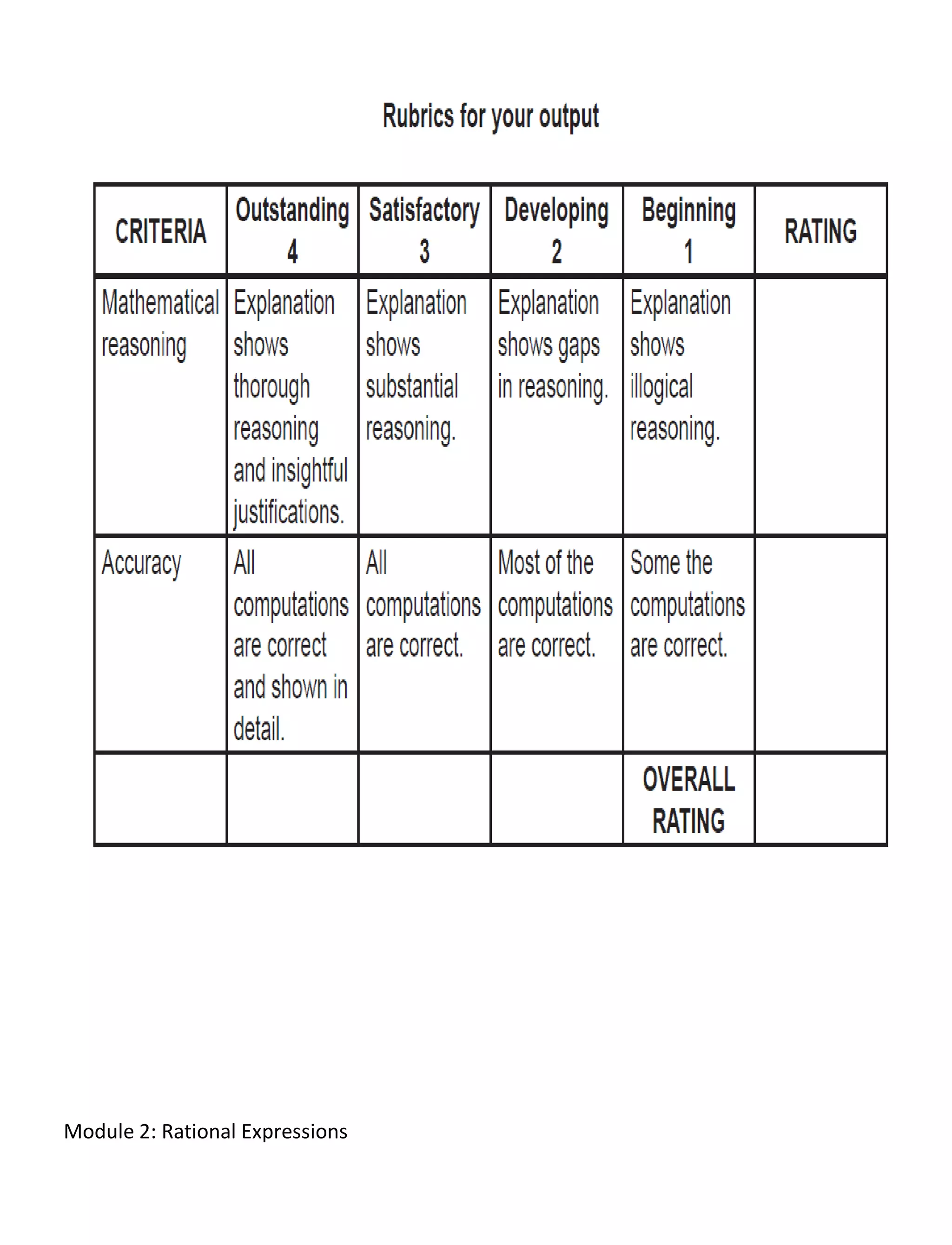This document provides instruction on rational expressions. It begins with a definition of rational expressions as algebraic expressions where both the numerator and denominator are polynomials. The document then outlines the key lessons to be covered: illustrating, simplifying, and performing operations on rational expressions. Examples are provided of simplifying rational expressions by factoring and canceling common factors between the numerator and denominator. The document also demonstrates multiplying rational expressions using the same rules as multiplying fractions, as well as canceling common factors.
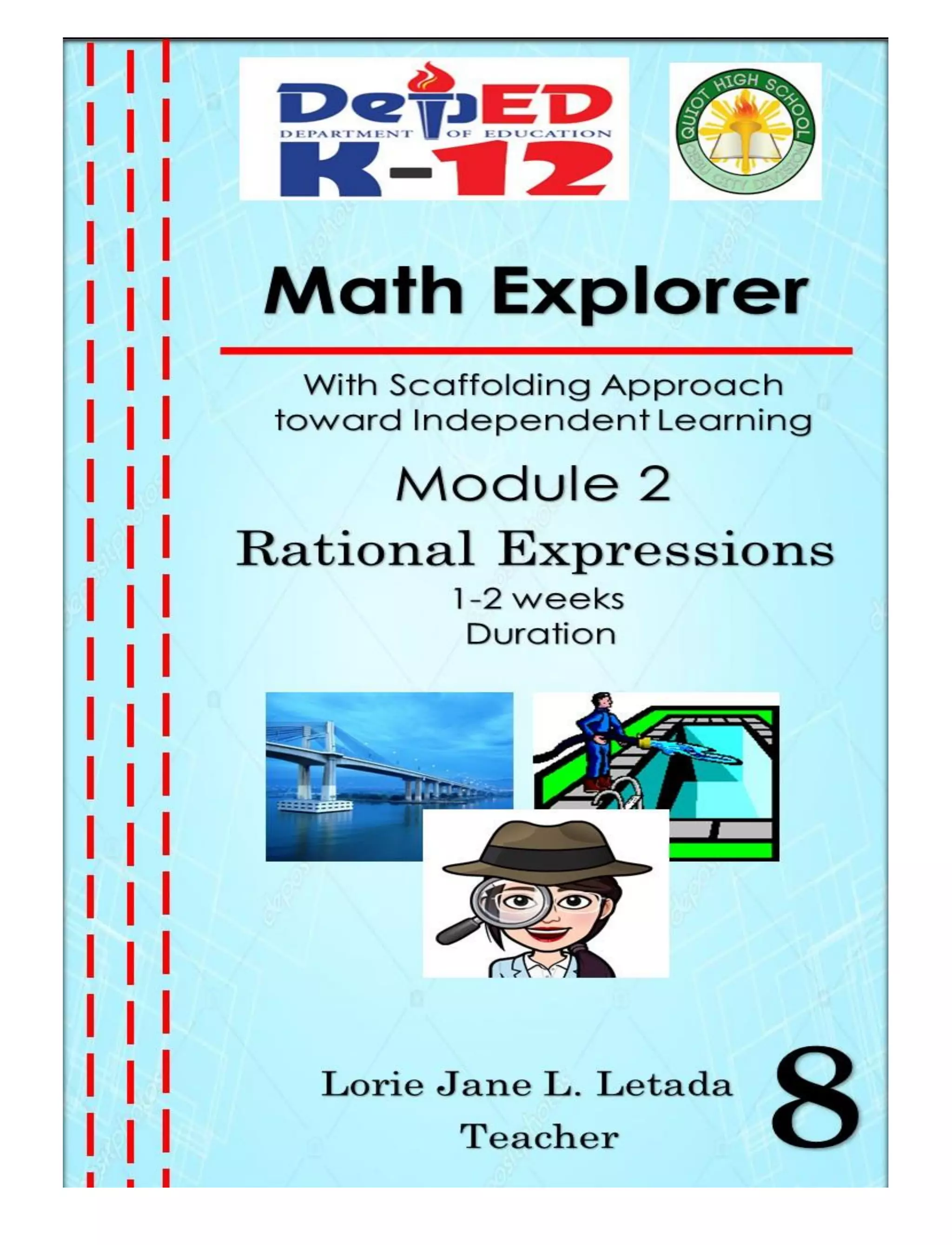
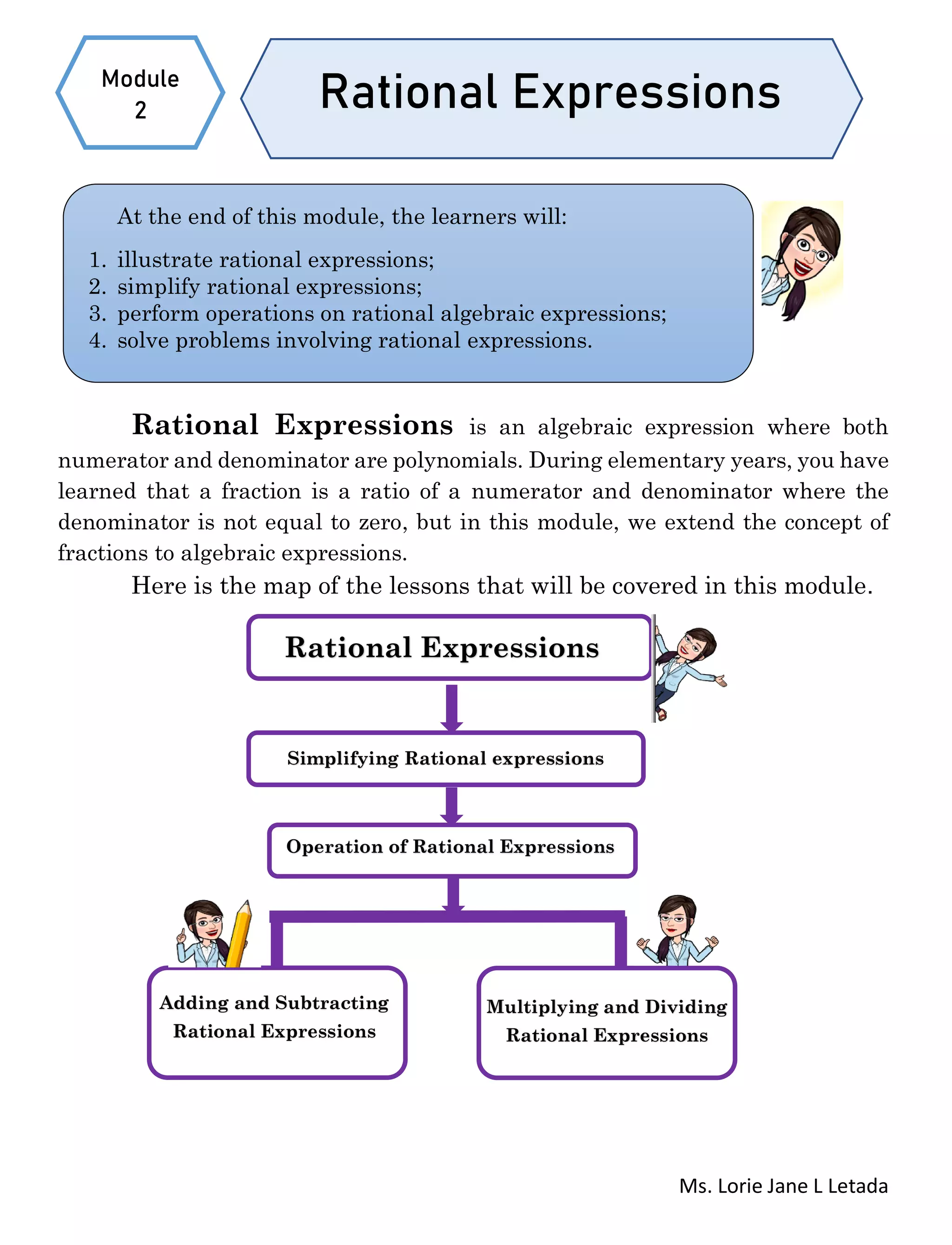
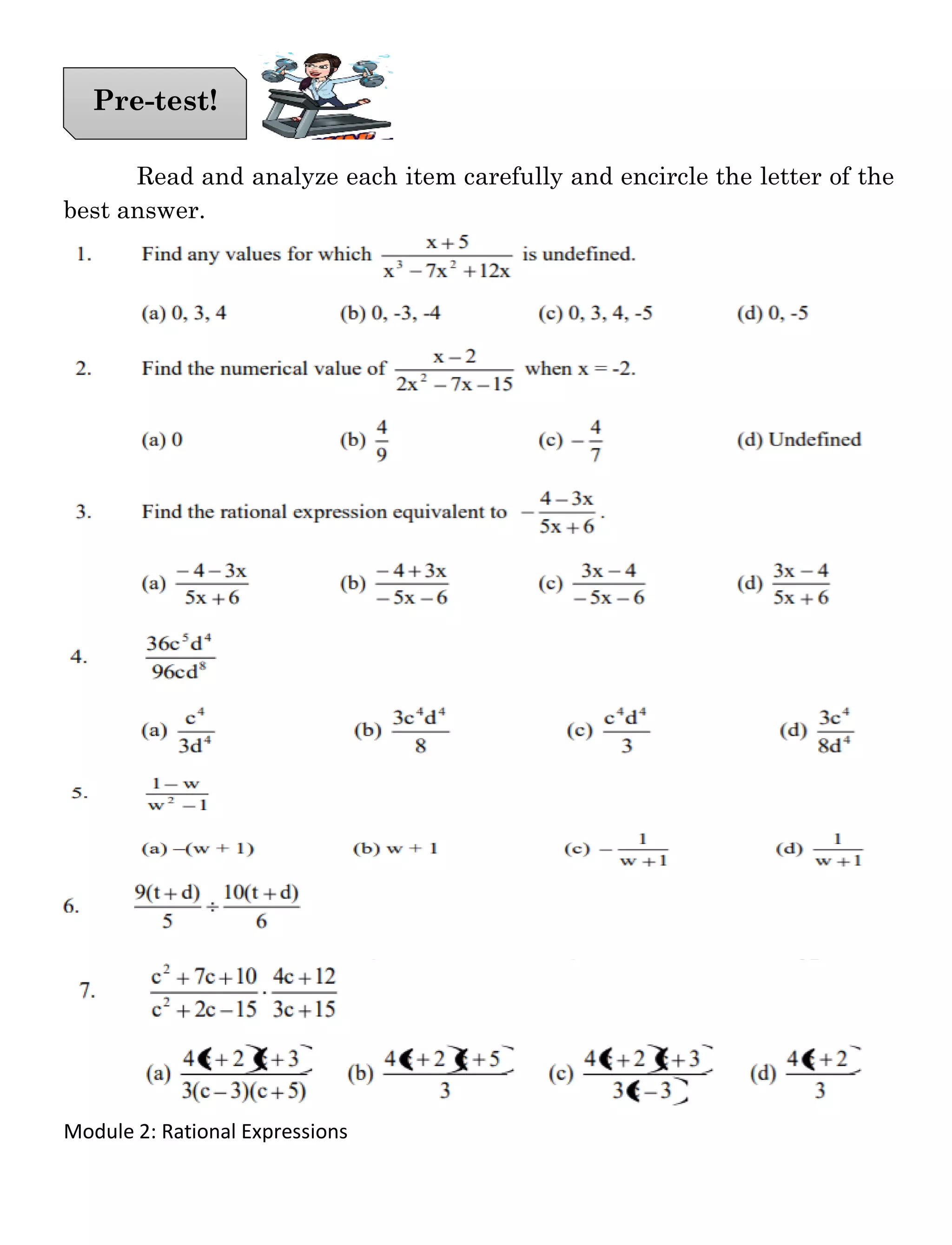

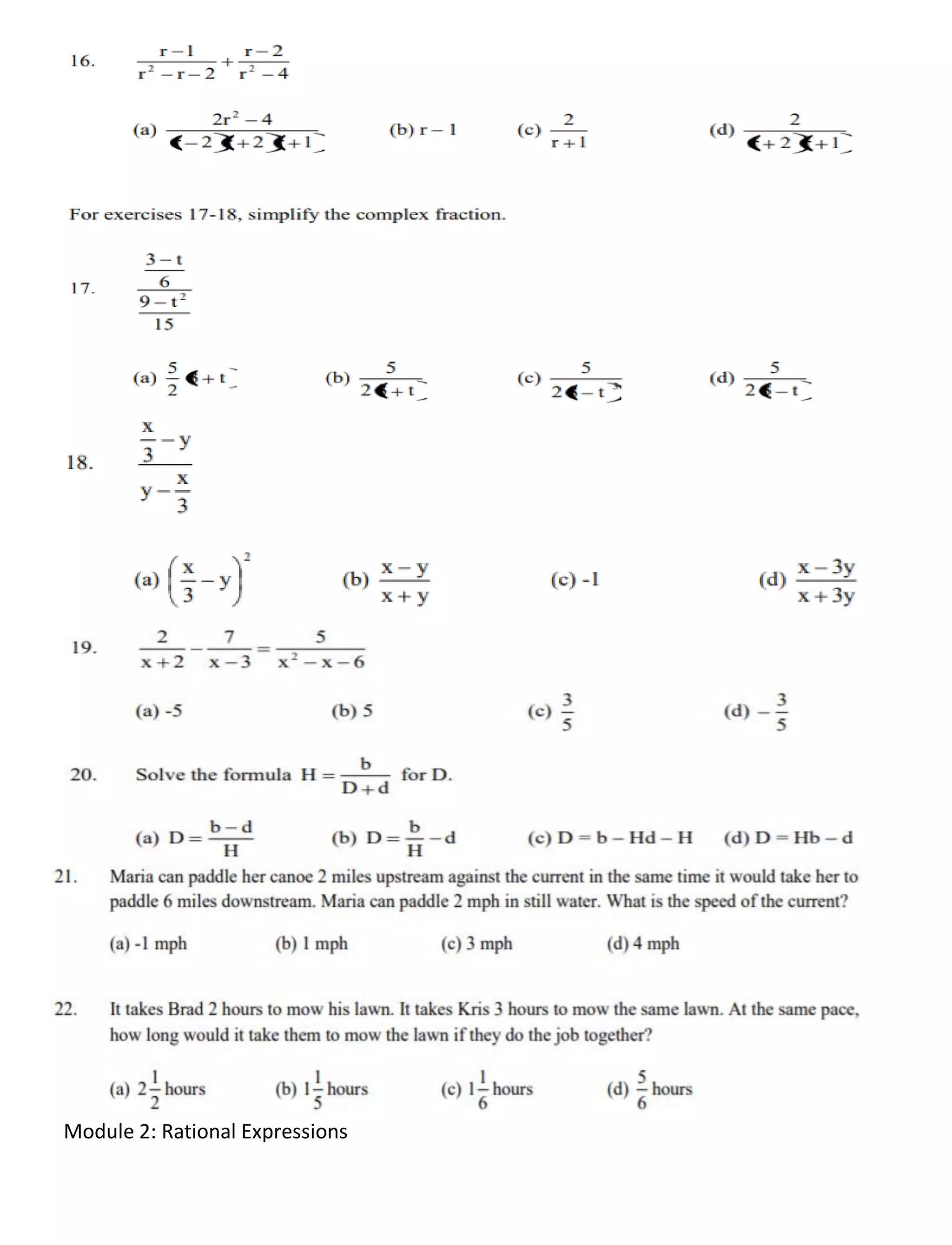


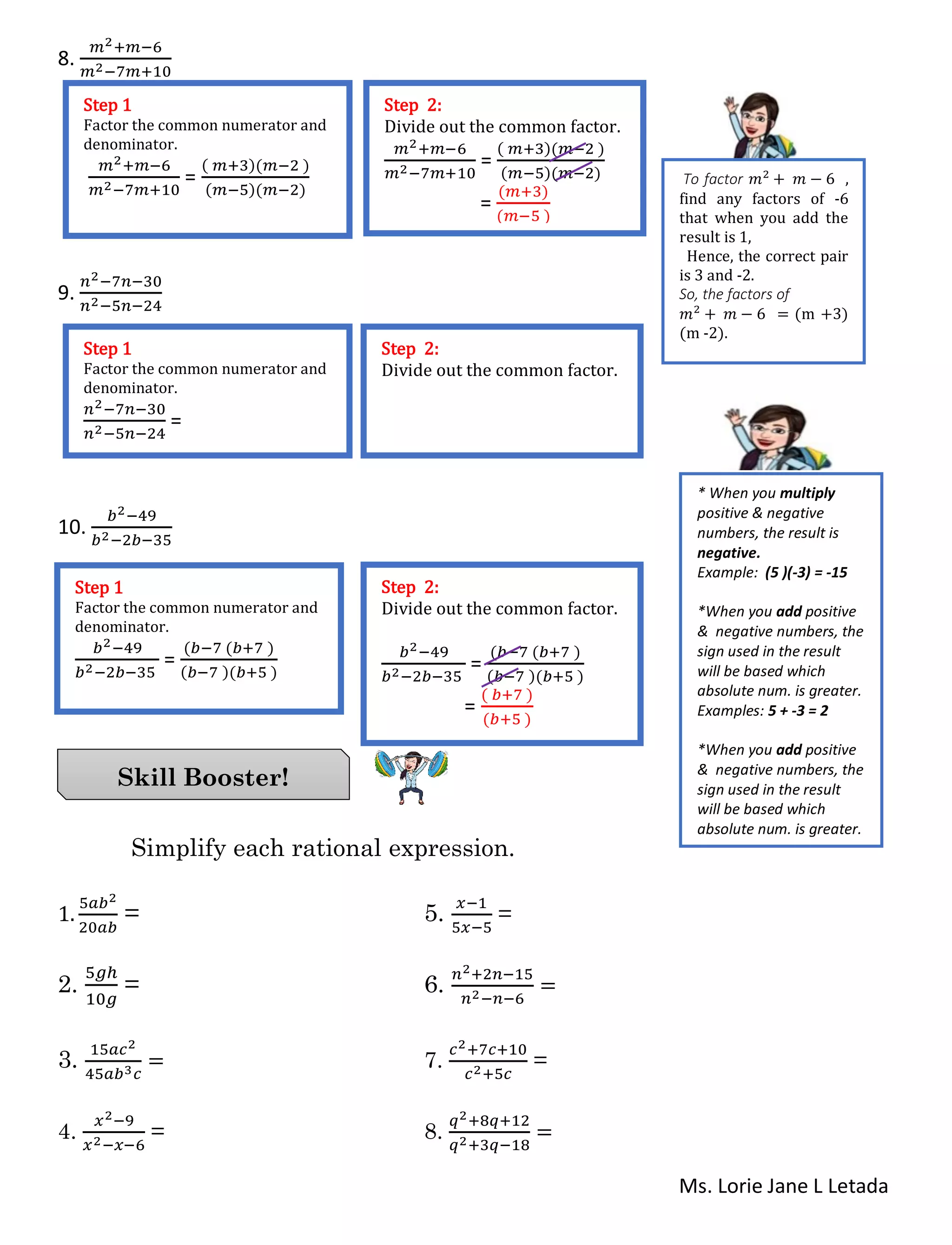
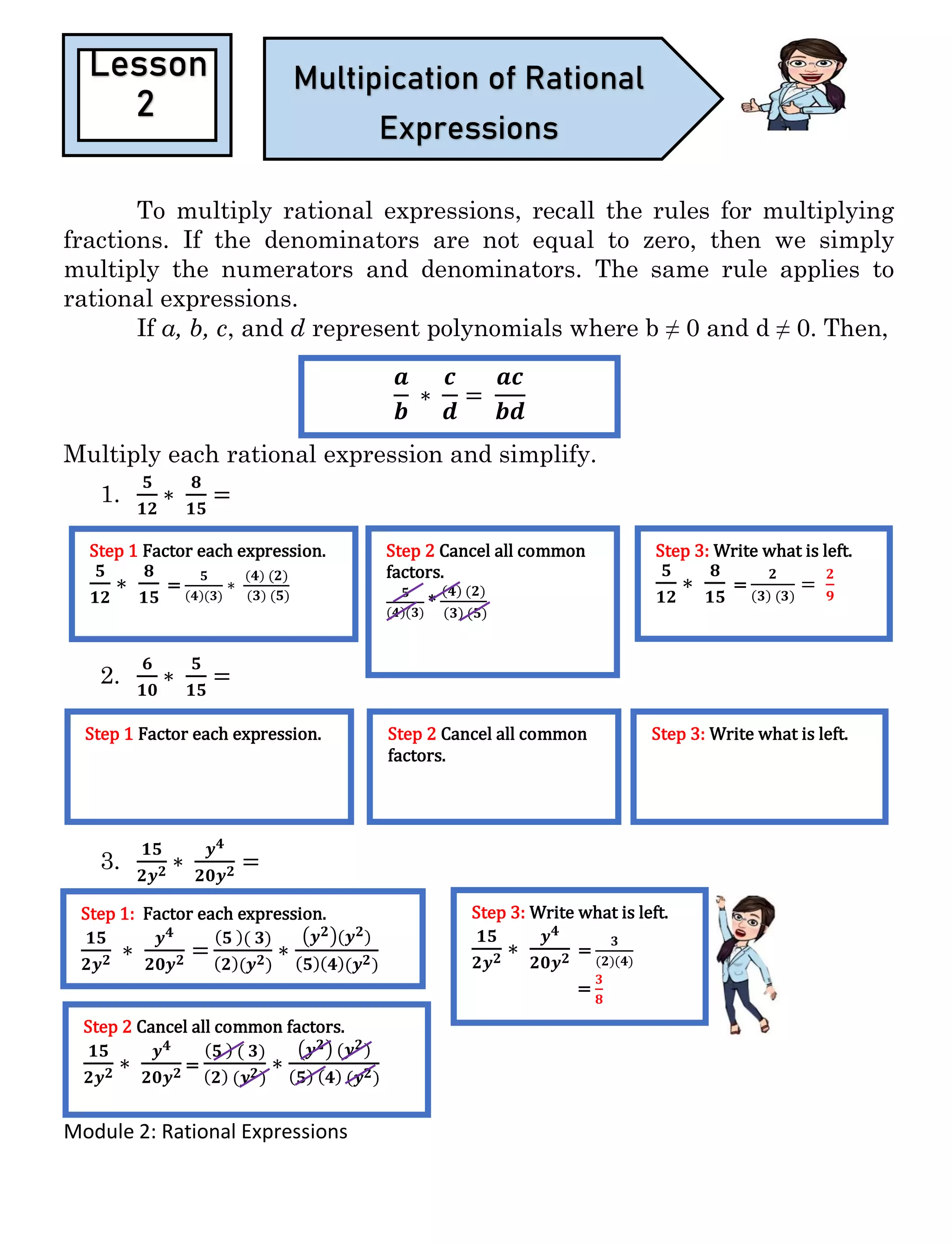
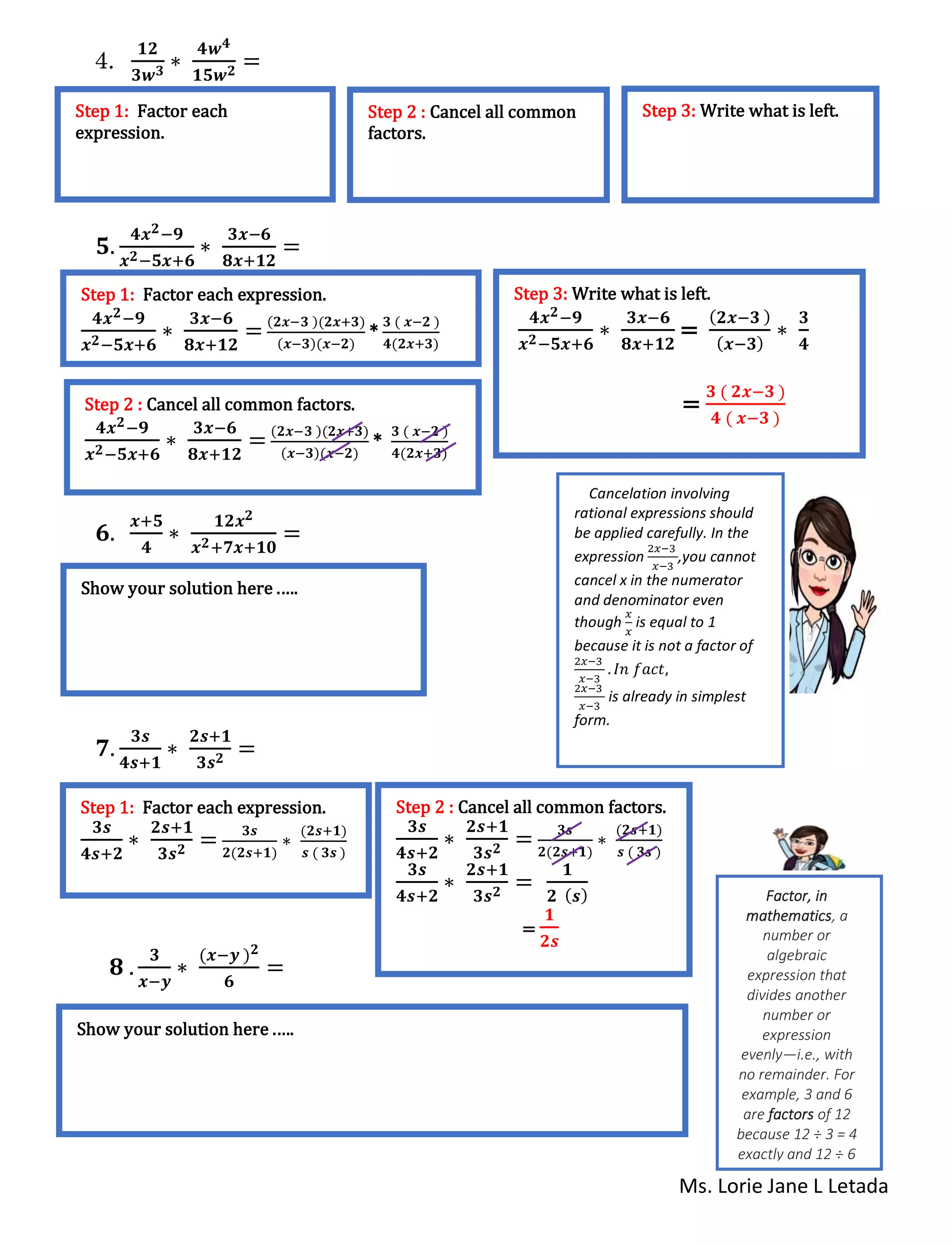
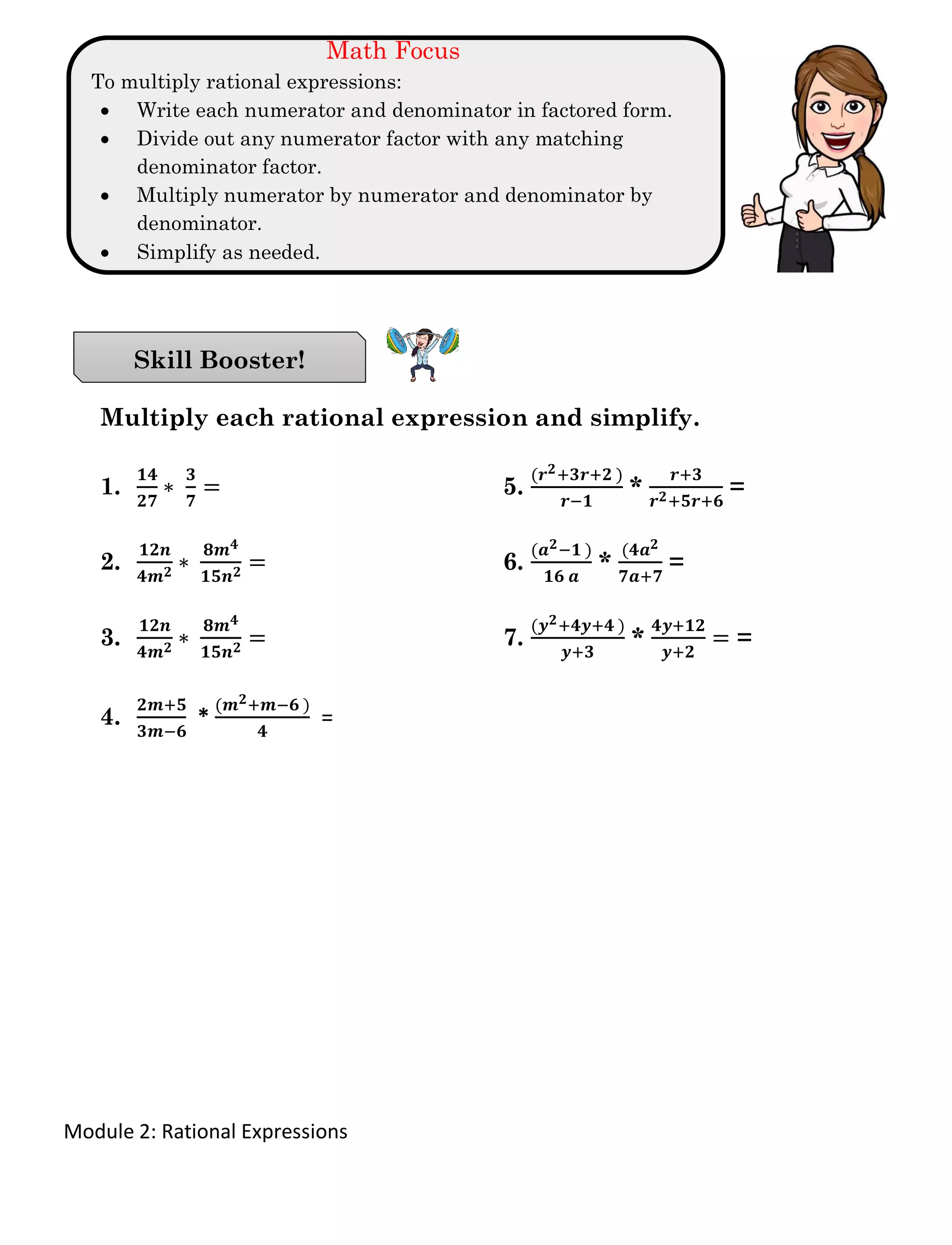
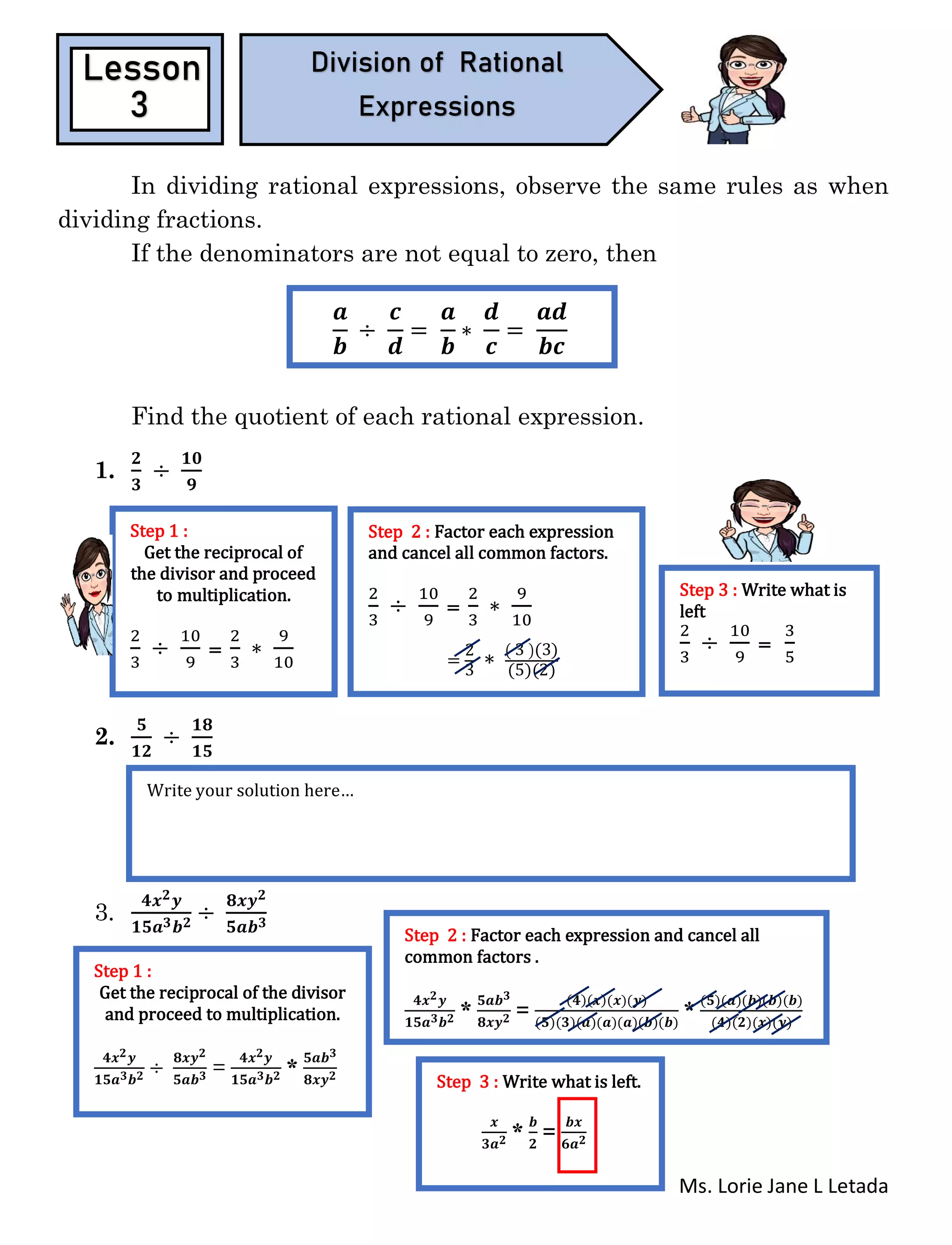
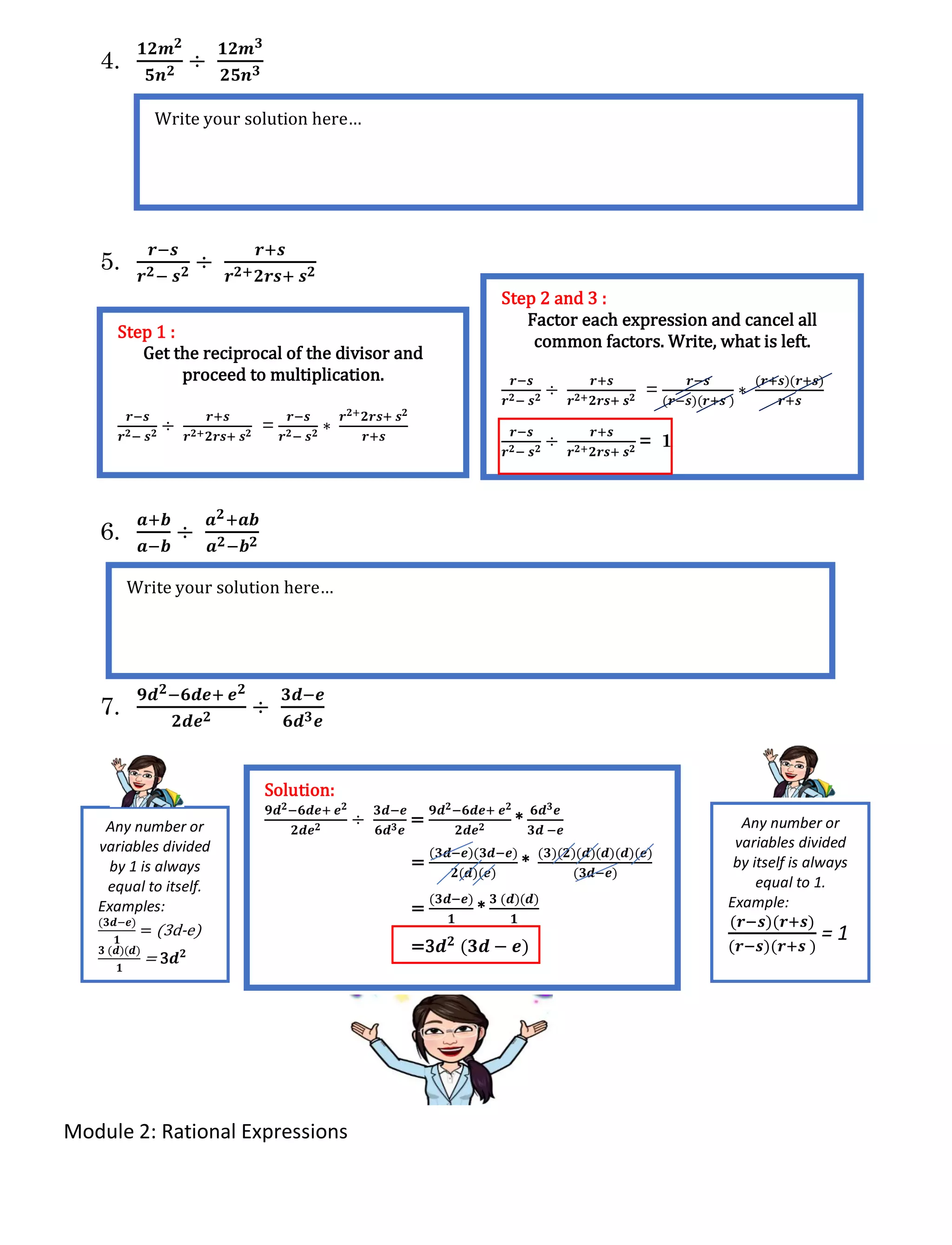
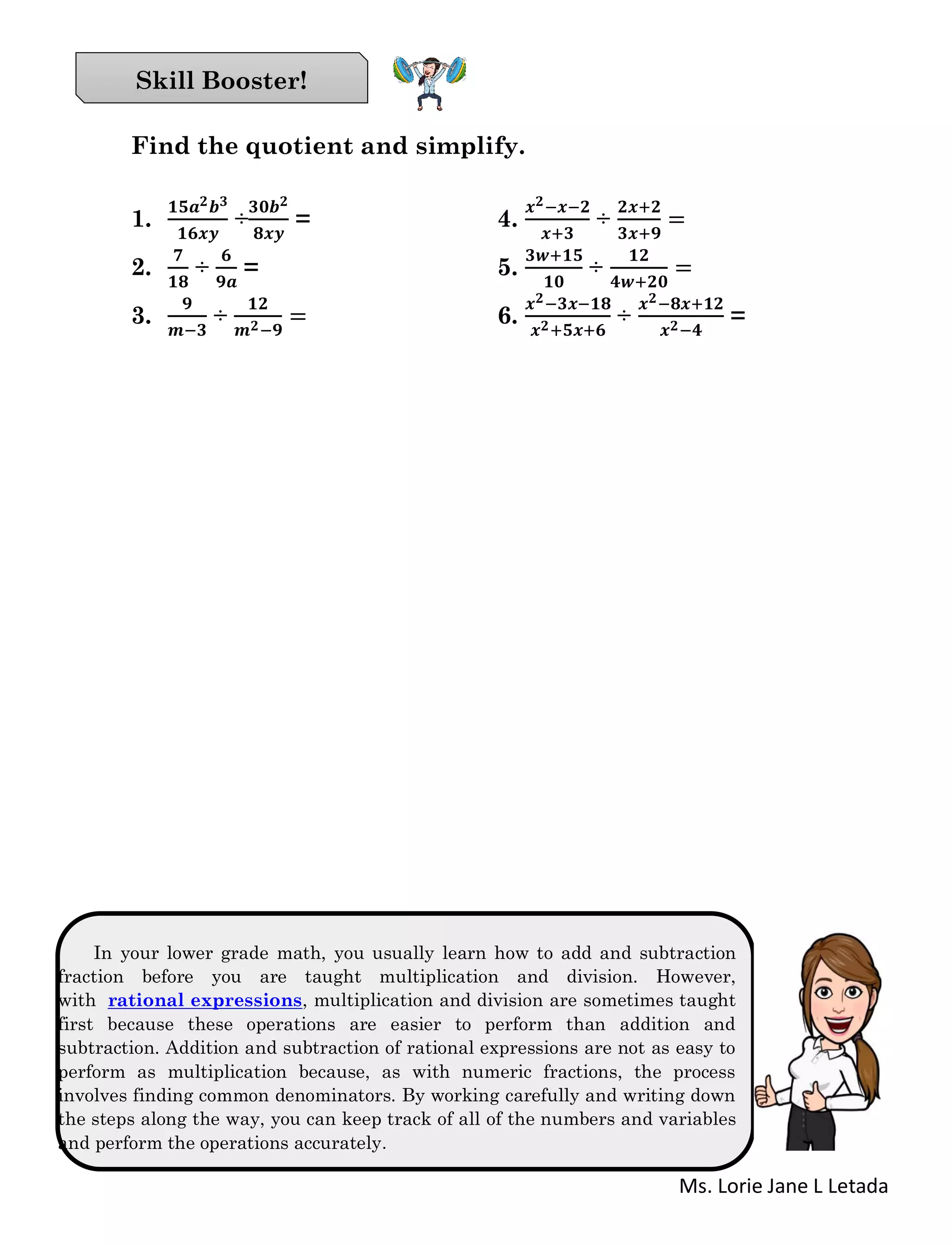
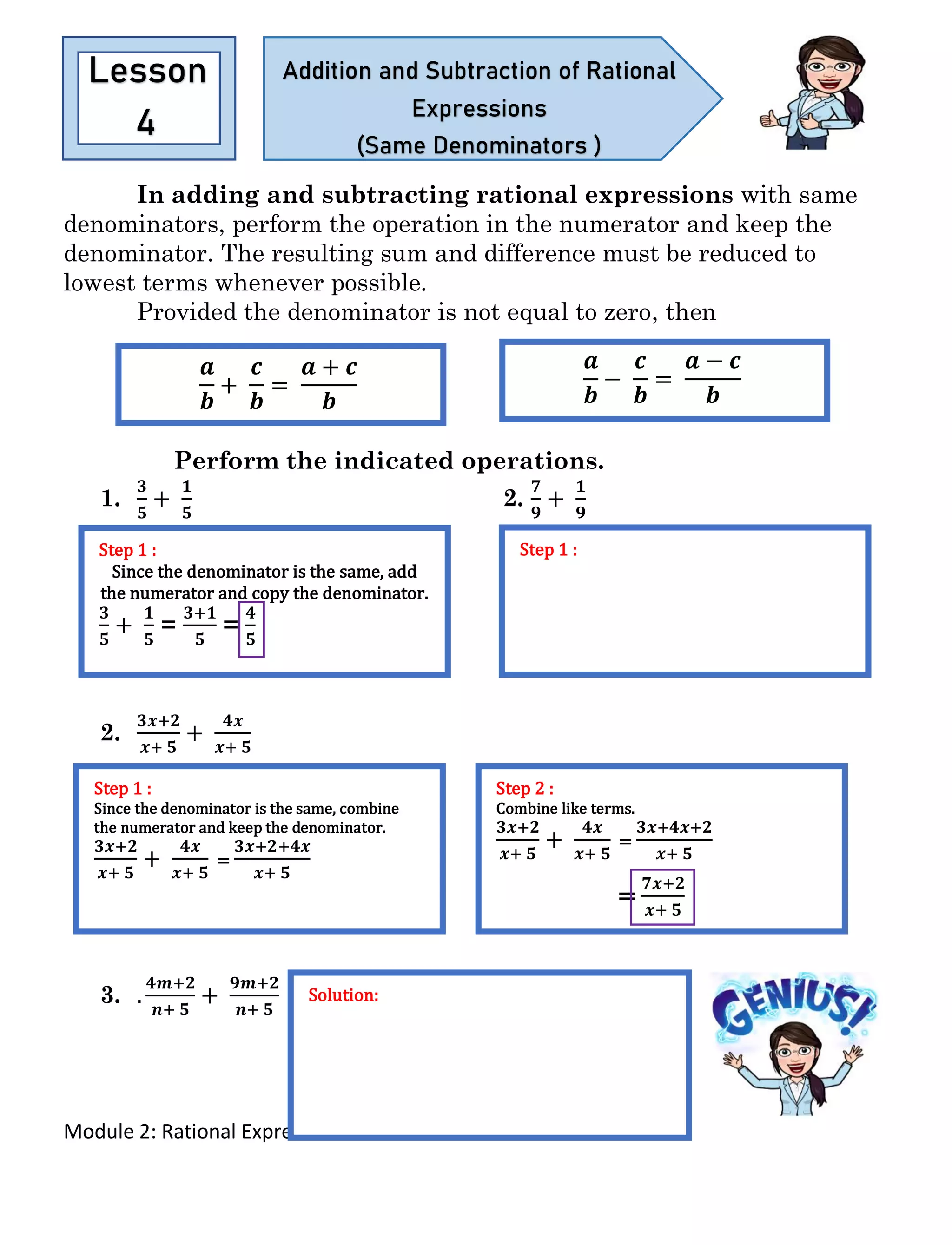
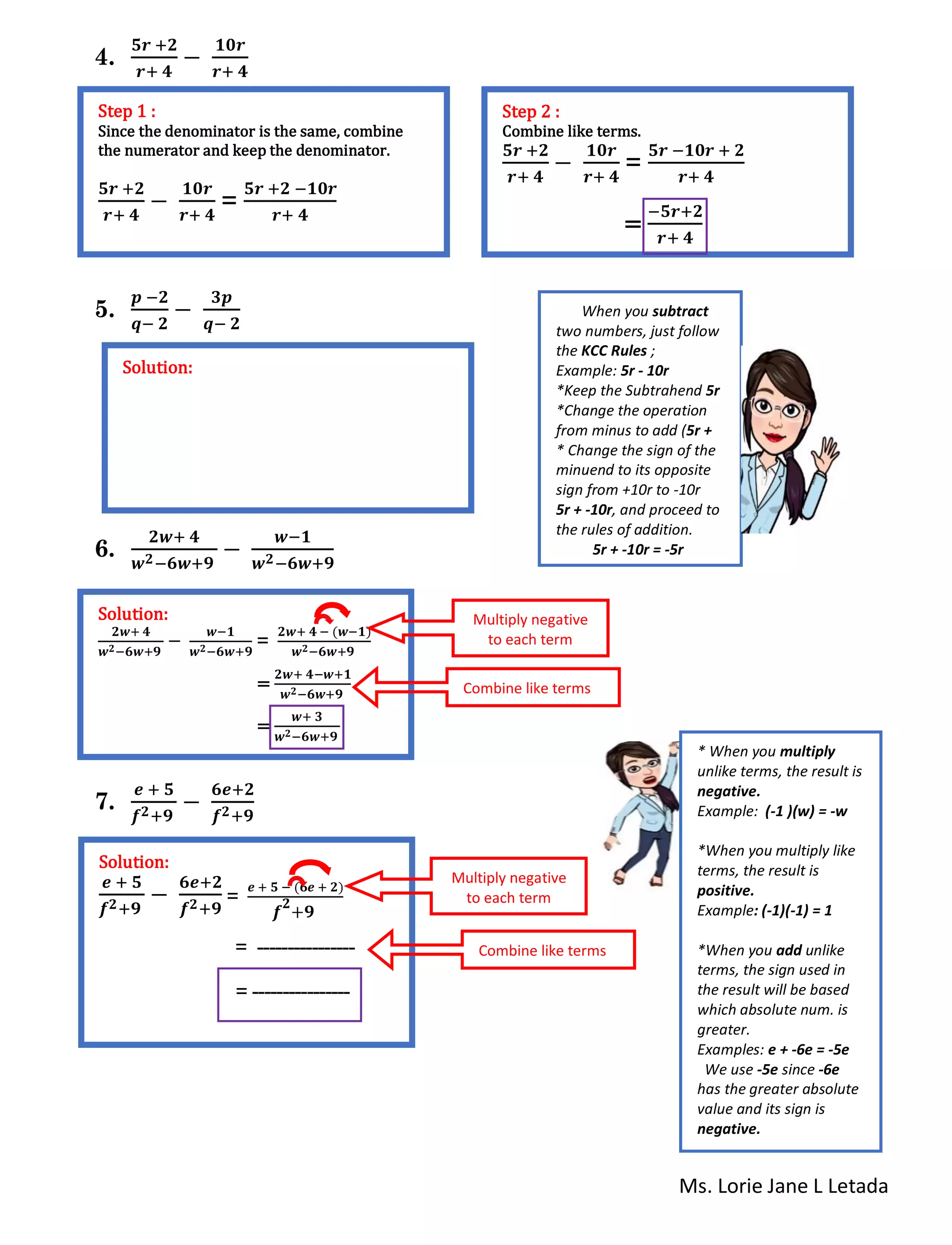
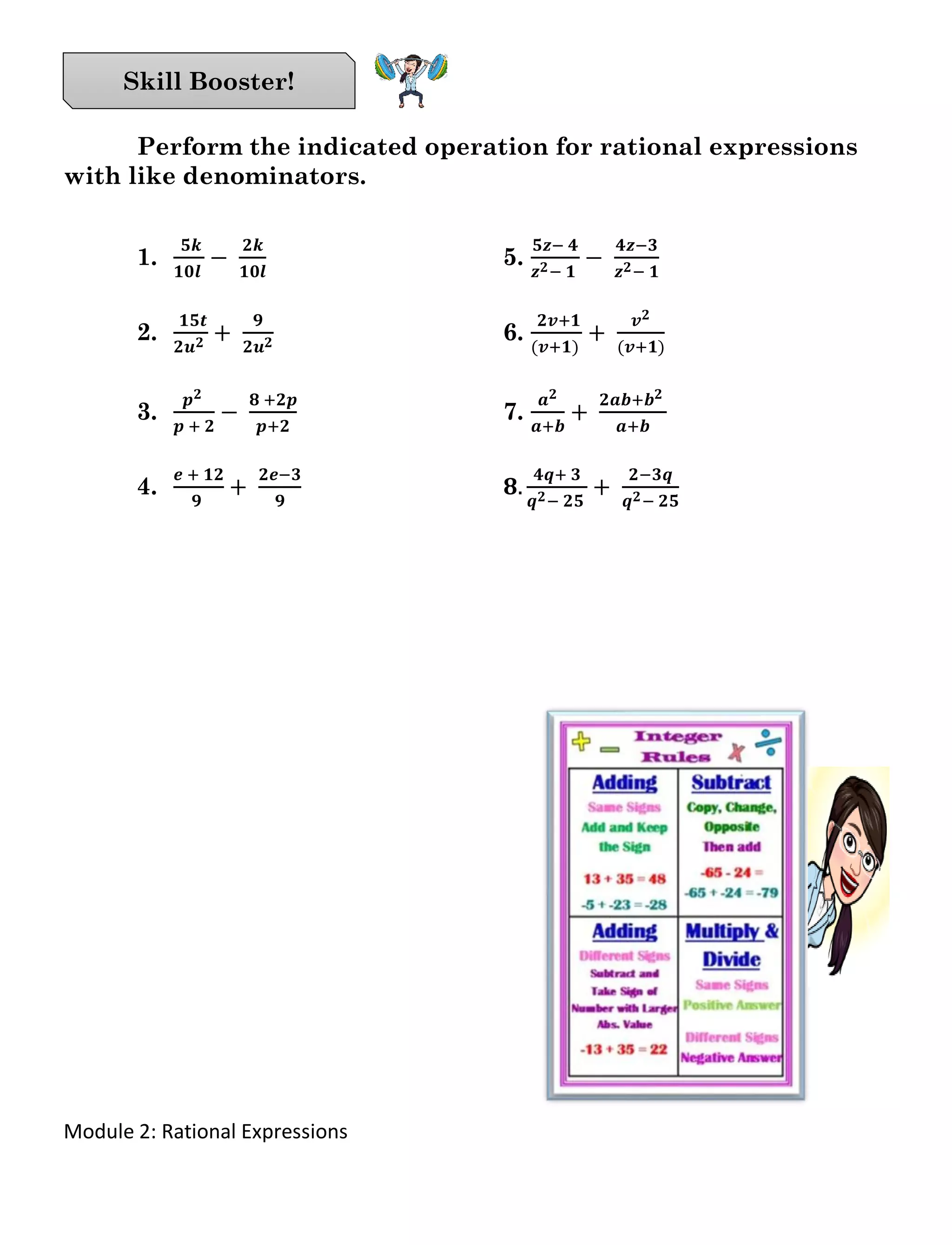
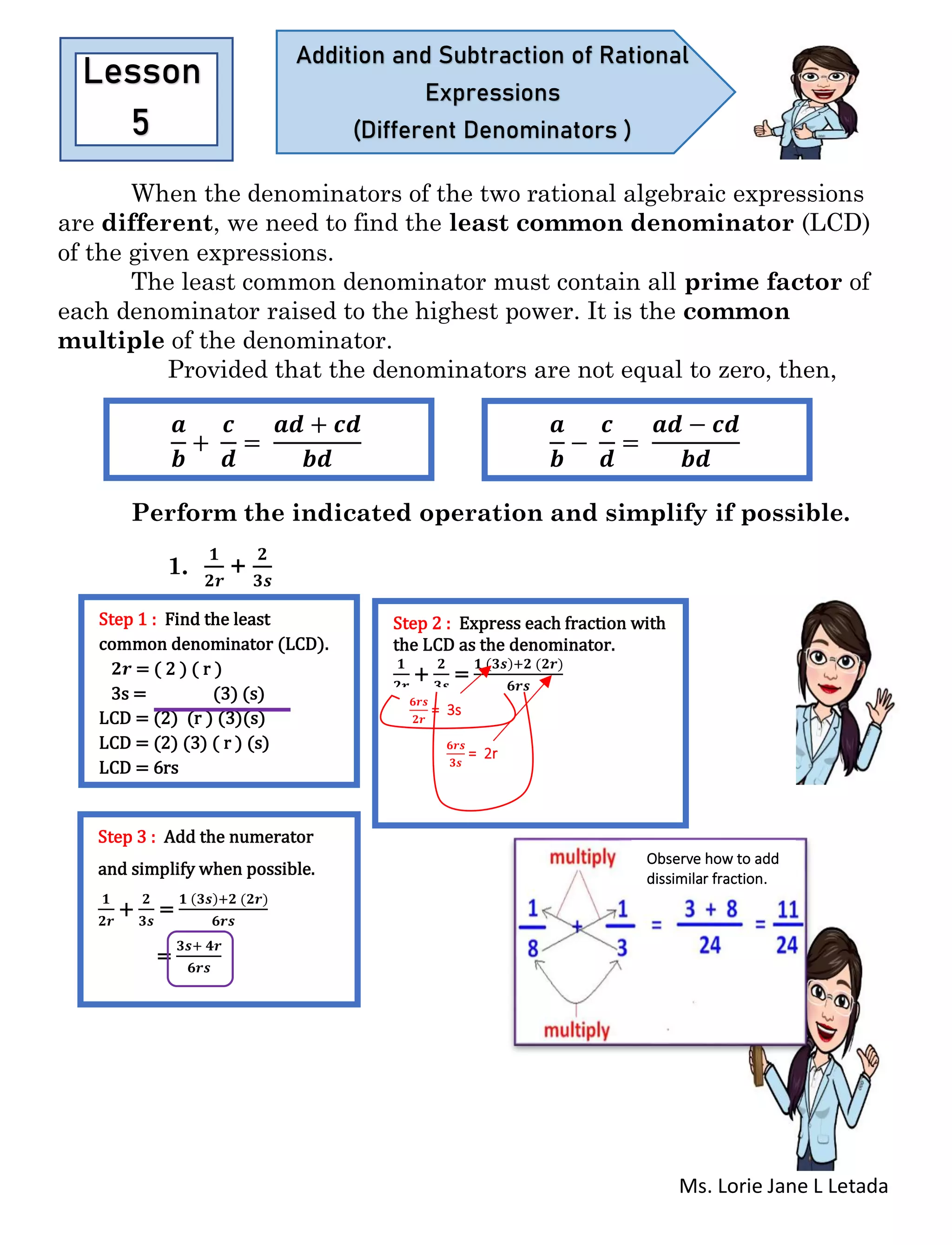
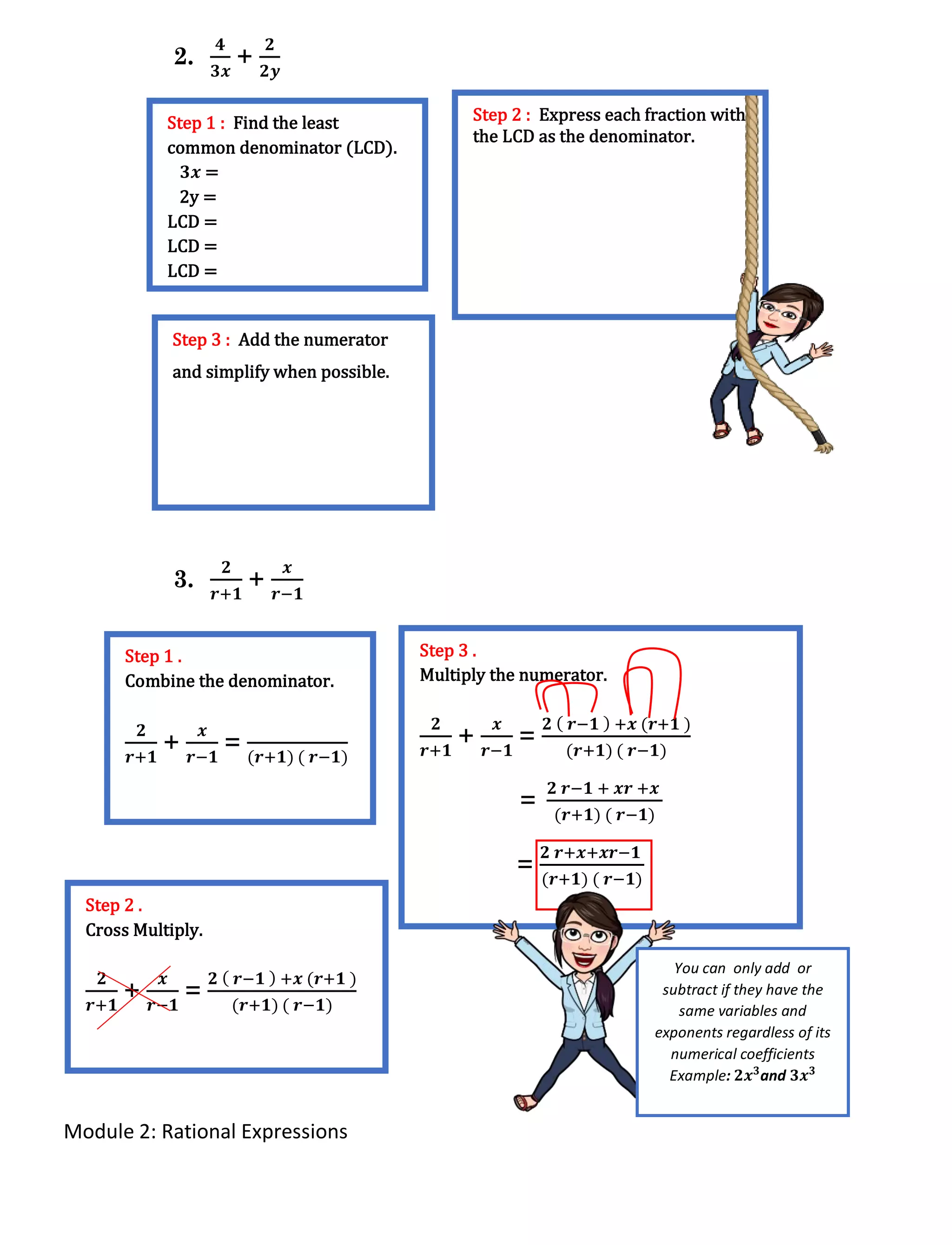
![Ms. Lorie Jane L Letada
4.
𝟐𝒙
𝒙 +𝟐
-
𝟓
𝒙−𝟐
5.
𝒙+𝟏
𝒙 +𝟐
-
𝒙−𝟏
𝒙−𝟐
n
Put your solution here…..
Step 1 .
Combine the denominator.
𝒙+𝟏
𝒙 +𝟐
-
𝒙−𝟏
𝒙−𝟐
=
( 𝒙+𝟏)−(𝒙−𝟏)
( 𝒙 +𝟐) (𝒙−𝟐 )
Step 2 .
Cross Multiply.
𝒙+𝟏
𝒙 +𝟐
-
𝒙−𝟏
𝒙−𝟐
=
[( 𝒙+𝟏)( 𝒙−𝟐 ) ]−[ ( 𝒙−𝟏)( 𝒙+𝟐 )]
( 𝒙 +𝟐)( 𝒙−𝟐)
Step 3 .
Multiply the numerator.
𝒙+𝟏
𝒙 +𝟐
-
𝒙−𝟏
𝒙−𝟐
=
[( 𝒙+𝟏)( 𝒙−𝟐 ) ]−[ ( 𝒙−𝟏)( 𝒙+𝟐 )]
( 𝒙 +𝟐)( 𝒙−𝟐)
𝒙+𝟏
𝒙 +𝟐
-
𝒙−𝟏
𝒙−𝟐
=
(𝒙 𝟐−𝟐𝒙−𝟐) −( 𝒙 𝟐−𝟐𝒙−𝟐 )
𝒙 𝟐−𝟒
Use FOIL method to
simplify these the
numerator.
Use FOIL method to simplify
these the denominator.
Step 4.
Simplify the numerator.
𝒙+𝟏
𝒙 +𝟐
-
𝒙−𝟏
𝒙−𝟐
=
(𝒙 𝟐−𝟐𝒙−𝟐) −( 𝒙 𝟐−𝟐𝒙−𝟐 )
𝒙 𝟐−𝟒
𝒙+𝟏
𝒙 +𝟐
-
𝒙−𝟏
𝒙−𝟐
=
𝒙 𝟐−𝟐𝒙−𝟐 − 𝒙 𝟐+ 𝟐𝒙 +𝟐
𝒙 𝟐−𝟒
𝒙+𝟏
𝒙 +𝟐
-
𝒙−𝟏
𝒙−𝟐
=
𝟎
𝒙 𝟐−𝟒
= 0
Multiply negative to each terms.
Combine like terms,](https://image.slidesharecdn.com/rationalexpressionsmodule-200715042836/75/Rational-Expressions-Module-20-2048.jpg)
![Module 2: Rational Expressions
6.
𝒎+𝟑
𝒎 + 𝟒
-
𝒏 −𝟏
𝒏− 𝟐
7.
𝒄 +𝟏
𝒅− 𝟐
-
𝒅 −𝟏
𝒄 − 𝟑
8.
𝒘 +𝟑
𝒒− 𝟏
+
𝒒 −𝟏
𝒘+ 𝟑
Put your solution here….
Solution:
𝒄 +𝟏
𝒅− 𝟐
-
𝒅 −𝟏
𝒄 − 𝟑
=
[( 𝒄 +𝟏)( 𝒄−𝟑)]−[( 𝒅−𝟏)(𝒅−𝟐)
( 𝒅− 𝟐)(𝒄−𝟑 )
=
(𝒄 𝟐−𝟐𝒄−𝟑 ) −(𝒅 𝟐−𝟐𝒅+𝟐)
𝒄𝒅−𝟐𝒄−𝟑𝒅+𝟔
=
𝒄 𝟐−𝟐𝒄−𝟑 − 𝒅 𝟐+𝟐𝒅−𝟐
𝒄𝒅−𝟐𝒄−𝟑𝒅+𝟔
=
𝒄 𝟐− 𝒅 𝟐−𝟐𝒄 +𝟐𝒅−𝟓
𝒄𝒅−𝟐𝒄−𝟑𝒅+𝟔
Cross multiply
Get the LCD
Use FOIL Method
Combine like terms
Solution:
Like Terms - both
terms have the
same variable
group abc; ex. abc
and 22abc
Unlike Terms are
terms that are not
in group ;example
−4𝑦3
and 5𝑥3
because the
variables are
different](https://image.slidesharecdn.com/rationalexpressionsmodule-200715042836/75/Rational-Expressions-Module-21-2048.jpg)
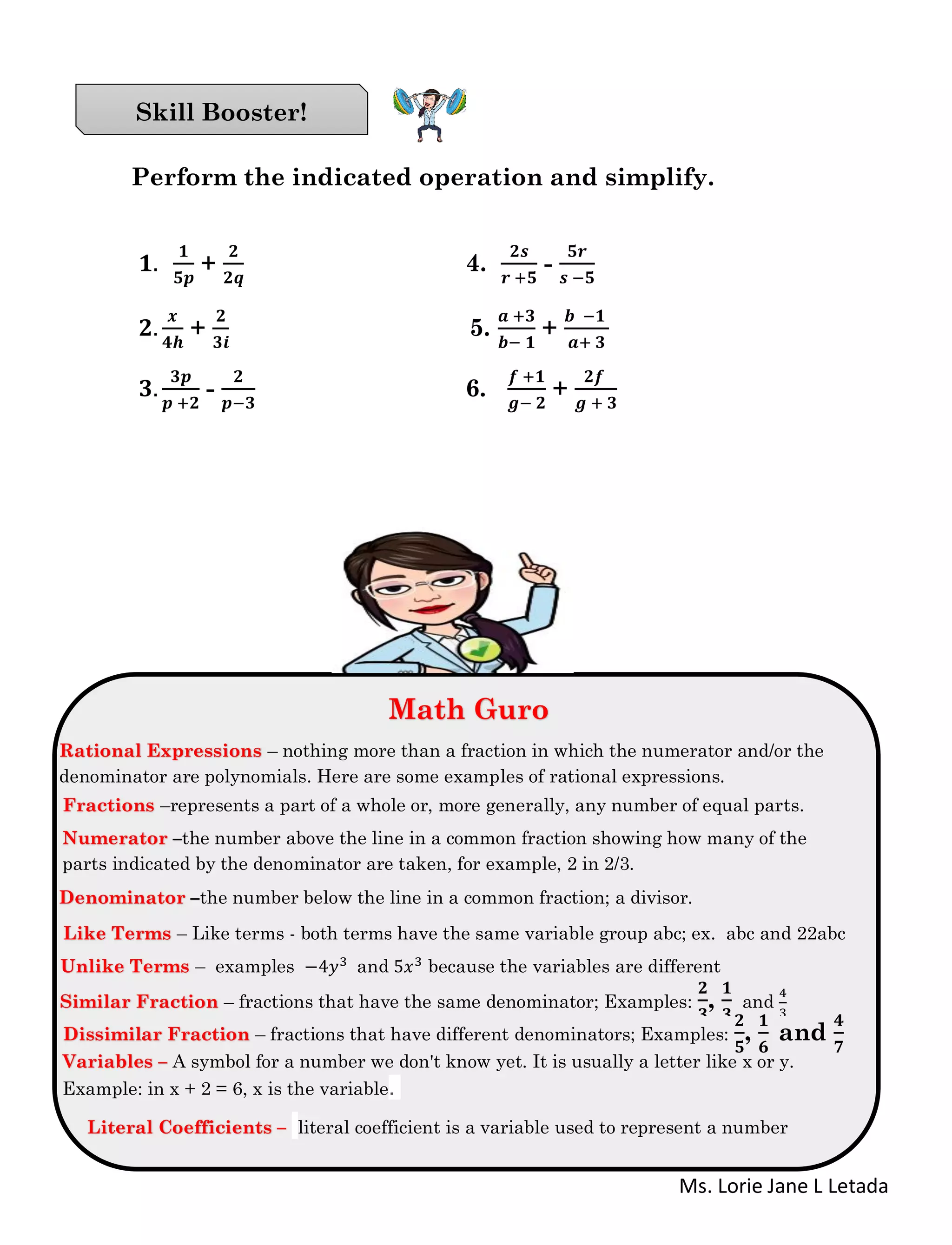
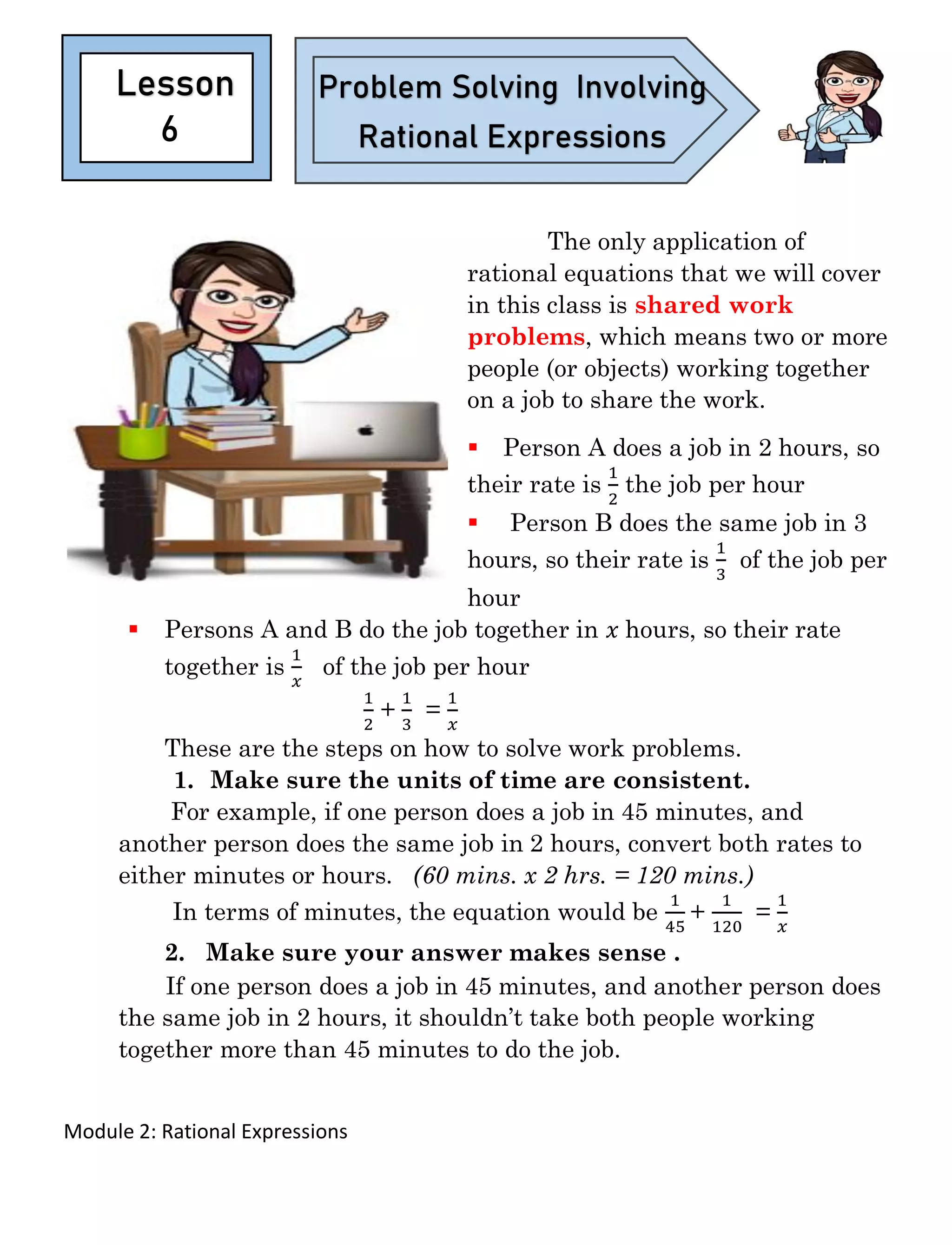
![Ms. Lorie Jane L Letada
1. It takes a boy 90 minutes to mow the lawn, but his sister can mow
it in an hour. How long (in minutes) would it take them to mow the
lawn if they worked together using two lawn mowers?
Let us look at the following problems.
Step 1:
Number of minutes that the
boy and his sister work
together
Step 2:
Let
1
𝑥
= number of mins.
work together
𝟏
𝟗𝟎
+
𝟏
𝟔𝟎
=
𝟏
𝒙
Step 3:
𝟏
𝟗𝟎
+
𝟏
𝟔𝟎
=
𝟏
𝒙
5400𝒙 [
𝟏
𝟗𝟎
+
𝟏
𝟔𝟎
=
𝟏
𝒙
] 5400x
60x + 90x = 5400
150x = 5400
𝟏𝟓𝟎
𝟏𝟓𝟎
𝒙 =
𝟓𝟒𝟎𝟎
𝟏𝟓𝟎
X = 36
Step 4:
Therefore, there are 36
minutes to mow the lawn.](https://image.slidesharecdn.com/rationalexpressionsmodule-200715042836/75/Rational-Expressions-Module-24-2048.jpg)
![Module 2: Rational Expressions
2. Two pipes can be used to fill a swimming pool. When the first pipe
is closed, the second pipe can fill the pool in 9 hours. When the
second pipe is closed, the first pipe can fill the pool in 7 hours. How
long (in hours) will it take to fill the pool if both pipes are open?
Round your answer to two decimal places.
Step 1:
Number of hours that both
pipes will fill the pool.
Step 2:
Let
1
𝑥
= number of hours
that the pipes will fill
together the pool
𝟏
𝟗
+
𝟏
𝟕
=
𝟏
𝒙
Step 3:
𝟏
𝟗
+
𝟏
𝟕
=
𝟏
𝒙
63𝒙 [
𝟏
𝟗
+
𝟏
𝟕
=
𝟏
𝒙
] 63x
7x + 9x = 63
16x = 63
𝟏𝟔
𝟏𝟔
𝒙 =
𝟔𝟑
𝟏𝟔
X = 3.94
X = 3 hrs. , 56
mins (0.94 x 60) and 15 sec
(.25 x 60)
Step 4:
Therefore, there are 3.94
hours( to fill the pool
together.
LCD (9,7, X)
63x ÷ 9
63𝑥
𝑥
LCD (9,7, X)
When you want to get
the LCD in a rational
equation and perform
the operation, make
sure to divide both side
with the LCD.
Example:
63𝒙 [
𝟏
𝟗
+
𝟏
𝟕
=
𝟏
𝒙
] 63x](https://image.slidesharecdn.com/rationalexpressionsmodule-200715042836/75/Rational-Expressions-Module-25-2048.jpg)
![Ms. Lorie Jane L Letada
3. Walter and Helen are asked to paint a house. Walter can paint
the house by himself in 12 hours and Helen can paint the house by
herself in 16 hours. How long would it take to paint the house if
they worked together?
4. On average, Mary can do her homework assignments in 100
minutes. It takes Frank about 2 hours to complete a given
assignment. How long (in minutes) will it take the two of them
working together to complete an assignment?
Step 1:
Step 2:
Step 3:
Step 4:
Step 1:
Number of minutes that both of
them will finish the assignment
together.
Step 2:
Let x = num. of minutes
Finish the task together
1
100
+
1
120
=
1
𝑥
Step 3:
𝟏
𝟏𝟎𝟎
+
𝟏
𝟏𝟐𝟎
=
𝟏
𝒙
12000𝒙 [
𝟏
𝟏𝟎𝟎
+
𝟏
𝟏𝟐𝟎
=
𝟏
𝒙
] 12000𝒙
120x + 100x = 12000
220x = 12000
𝟐𝟐𝟎
𝟐𝟐𝟎
𝒙 =
𝟏𝟐𝟎𝟎𝟎
𝟐𝟐𝟎
x = 54.55
x = 54.55 mins
Step 4:
Therefore, there are 54.55 minutes
to finish the assignment together.](https://image.slidesharecdn.com/rationalexpressionsmodule-200715042836/75/Rational-Expressions-Module-26-2048.jpg)
